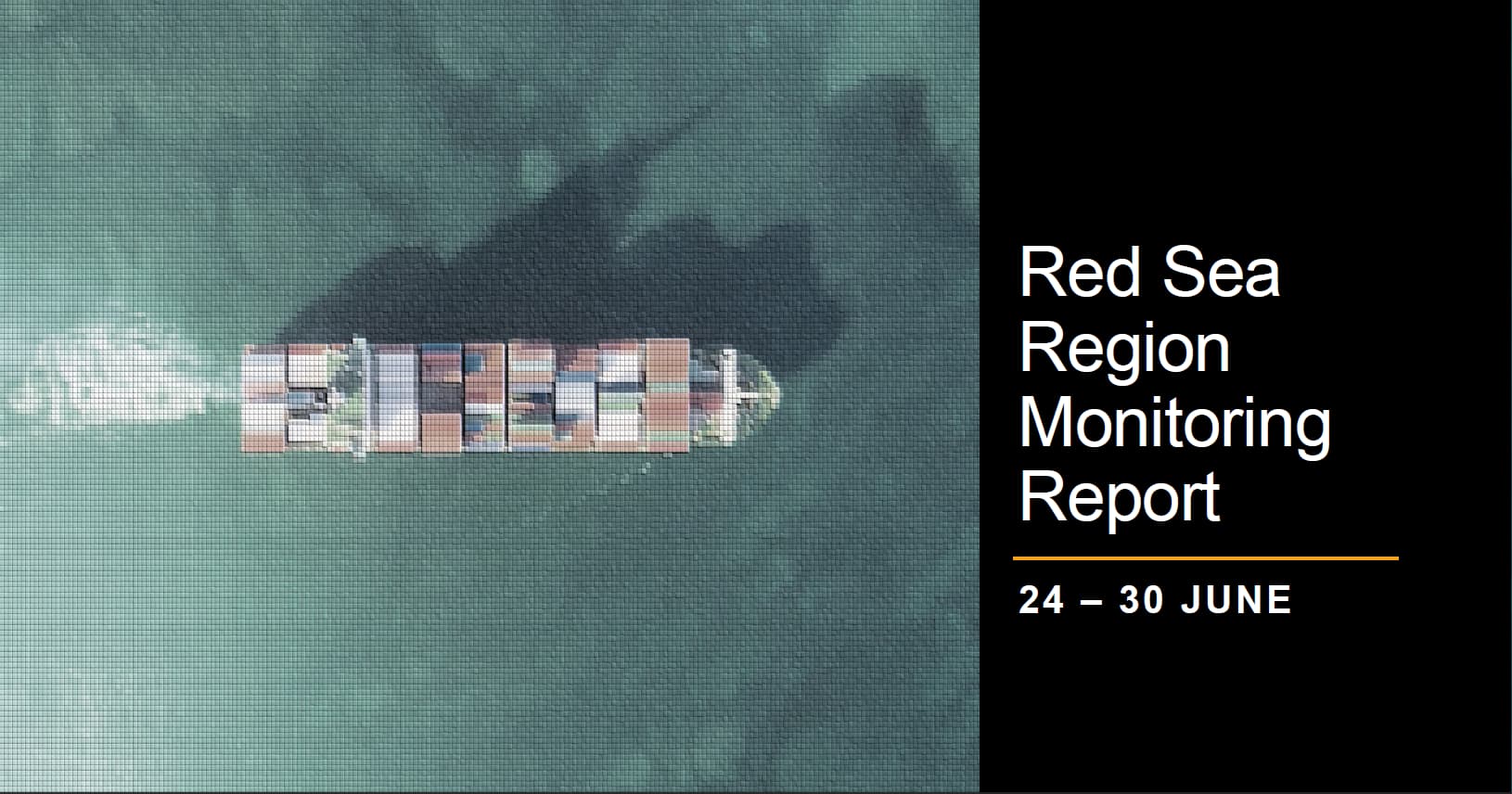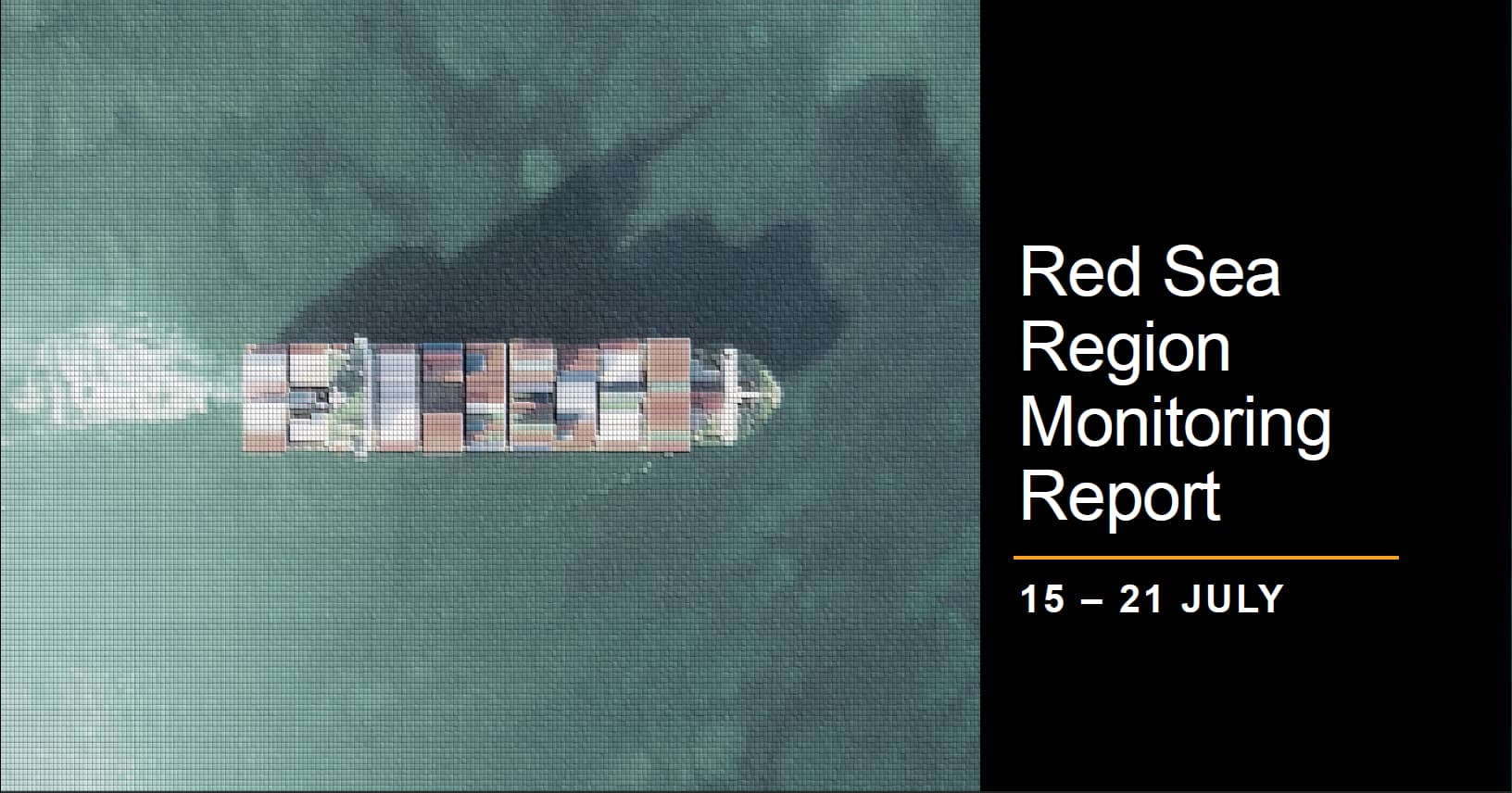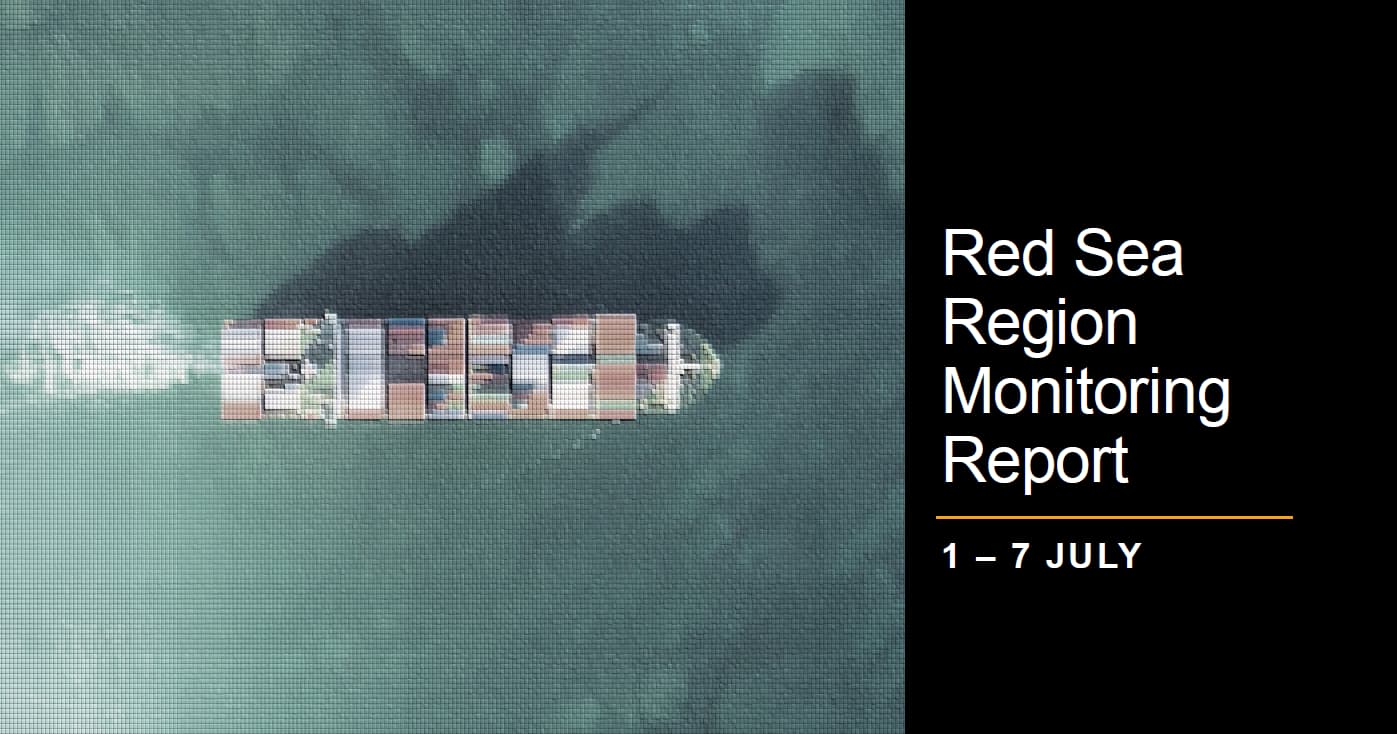KEY DEVELOPMENTS – COMMERCIAL INCIDENTS
During the monitoring period 26 February – 3 March Regal Maritime Solutions (RMS) identified the following incidents in the Red Sea and Gulf of Aden region, obtained from a variety of open sources including UKMTO and the United States (US) military:
SUSPICIOUS ACTIVITY: On 27 February three small vessels, dark in colour with 2 people aboard each craft were detected approximately 90NM east of Ras Al Misham, Saudi Arabia. No weapons or uniforms were visible on those aboard. All three vessels followed a commercial vessel for approximately an hour at less than 1NM.
MISSILE ATTACK: On 27 February a missile was sighted on the starboard side of a commercial vessel travelling in the southern Red Sea, approximately 60NM west of Al Hudayadeh, before it impacted 3-5NM from the port bow. The vessel and crew were reported as safe and continued to its next port of call.
MISSILE STRIKE: On 2 March the MV Rubymar that was struck by a Houthi launched missile on 18 February was reportedly sinking after having reportedly taken water aboard since the date of the incident. The Rubymar was subsequently confirmed by the US military as having sunk later in the day.
SUSPICIOUS ACTIVITY: An unnamed hijacked fishing dhow was reportedly identified as having departed Jiifle, Somalia at 1800 UTC with 11 armed individuals aboard according to the Maritime Security Centre Horn of Africa (MCSHOA). The activity is believed to be linked to a Piracy Action Group (PAG).

KEY DEVELOPMENTS – MILITARY ACTIVITY
During the monitoring period 26 February – 3 March RMS identified the following incidents involving US coalition forces in the Red Sea and Gulf of Aden region, obtained from military and open sources:
USV IINTERCEPT: On 26 February between 1645 and 2345 local time, US naval forces destroyed three unmanned surface vessels (USV) in a pre-emptive strike after identifying and locating the USVs in Houthi-controlled territory in Yemen.
MISSILE INTERCEPT: On 26 February US forces destroyed two mobile anti-ship cruise missiles (ASCM) in a pre-emptive strikes on Houthi-controlled territory in Yemen.
UAV INTERCEPT: On 26 February US forces located and destroyed a one-way attack unmanned aerial vehicle (UAV) in a pre-emptive strike on Houthi-controlled territory in Yemen.
UAV INTERCEPT: On 27 February between 2150 and 2255 local time, US aircraft and a coalition warship shot down five Iranian-backed Houthi one-way attack (OWA) UAVs in the Red Sea. Coalition forces identified the UAVs as originating from Houthi-controlled areas of Yemen and determined they presented an imminent threat to vessels in the region.
UAV INTERCEPT: On 29 February at approximately 1710 local time the US navy shot down a UAV over the southern Red Sea which it considered a threat to US naval assets in the area.
MISSILE INTERCEPT: On 29 February between 1800 and 1915 local time US forces conducted two pre-emptive strikes against six mobile anti-ship cruise missiles (ASCMs) that were prepared to launch towards the Red Sea and considered an imminent threat to commercial and coalition vessels in the region.
MISSILE INTERCEPT: On 1 March at approximately 1240 local time, US forces carried out a pre-emptive strike on a Houthi surface-to-air missile that was prepared to launch from Houthi controlled areas of Yemen towards the Red Sea which it determined presented an imminent threat to US aircraft in the region.
MISSILE ATTACK: On 1 March at approximately 2245 local time, Houthis militants launched an anti-ship ballistic missile (ASBM) from Yemen into the Red Sea but did not hit any vessels.
UAV INTERCEPT: On the afternoon, 2 March, the Italian warship Nave Caio Duilio, identified and shot down a UAV in self-defence in the Red Sea after identifying the UAV heading towards its position at a range of approximately six kilometers. The Nave Caio Duilio forms part of the Italian navy’s contribution to the European multinational operation in the Red Sea region, EUNAVFOR Operation Aspides, joining the Spanish warship ESPS Victoria in the area.
RUBYMAR UPDATE: On 2 March at approximately 0215 local time, the MV Rubymar sank in the Red Sea after being struck by an Houthi anti-ship ballistic missile on 18 February, according to the US military (see image below). The ship had been slowly taking on water since the attack. The ship now presents a subsurface impact risk to other vessels transiting the shipping lanes. Its cargo of around 21,000 metric tons of ammonium phosphate sulfate fertilizer also presents an environmental risk in the Red Sea area.

KEY DEVELOPMENTS – HOUTHI MISSILE STATISTICS

Figures
1 and 2 identifies the number of missiles, UAV, USVs and UUVs launched, or prepared to be imminently launched, by Houthi militants from Yemen targeting both commercial and naval vessels in the Red Sea and Gulf of Aden regions from data available from UKMTO, the US military and OSINT sources. Both figures have incorporated statistics from vessels hit, near misses and pre-emptive strikes on-land in Yemen by US-led Coalition forces but not those resulting from large scale coordinated military action. In some cases the destined target of Houthi weapons destroyed on-land in Yemen cannot not be verified and has therefore been categorized as ‘Not Known’ (NK). Where no dates are provided there were no reported incidents or data available for that period.

1 Jan – 3 Mar 2024
REGIONAL DEVELOPMENTS
During the monitoring period 26 February – 3 March RMS identified the following key regional developments:
Yemen’s internationally recognised government (IRG), which controls Yemeni territory separate to that controlled by the Houthis, have expressed concern at the sinking of the MV Rubymar warning of an “environmental catastrophe” in the Red Sea caused by its cargo of 21,000 metric tonnes of ammonium phosphate sulphate fertiliser.
The sinking of the Rubymar is unlikely to impact insurance costs according to industry experts due to its low value and the fact that it was already operating in a high risk area, best advised to avoid, before it had sank. Insurance industry sources claim that war risk premiums quoted for Red Sea route have remained around 1 percent of the value of a vessel over the past few weeks, compared with approximately 0.5 percent before the attacks began with underwriters applying various discounts.
The US conducted the first of a series of humanitarian aid air drops into Gaza on 2 March as part of an emergency humanitarian assistance authorised by US President Joe Biden. This follows the incident on 29 February in which more than 100 Palestinians were shot and killed by Israel Defense Forces (IDF) in Gaza City whilst chaotically attempting to pull food supplies and goods off an aid convoy entering the territory. The action was conducted in coordination with the Jordanian Air Force. The US indicated the action was not a reflection of a failure in its cooperation with Israel.
Israeli war cabinet minister and main political opposition leader to Israeli Prime Minister Benjamin Netanyahu, Benny Gantz travelled to the US on 3 March to meet with senior government representatives including Vice President Kamala Harris and US National Security Advisor Jake Sullivan to discuss the ongoing Israeli military operations in Gaza, explore the promotion of a security arrangement in Lebanon and reach a deal for the release of Israeli hostages still held by Hamas. The trip by Gantz was not authorised by PM Netanyahu resulting in elevated tensions between the two, reflecting the challenging disunity within Netanyahu’s war cabinet as the Israel-Hamas conflict continues and risk from potential political challengers.
On 2 March Yemen’s Houthi Transport Minister confirmed there had been a “glitch” in undersea communication cables in the Red Sea proportioning blame on US and UK naval vessels and thus endangering the security and safety of international communications. This announcement came after Yemen’s IRG previously disclosed the Houthi’s potential intent to disrupt underwater sea cables.
On 3 March Yemen’s Houthi Deputy Foreign Minister Hussein al-Ezzi, reiterated the groups commitment to sink more British ships after attacking the Rubymar cargo vessel, “Yemen will continue to sink more British ships, and any repercussions or other damages will be added to Britain’s bill,” said Hussein al-Ezzi, Houthi deputy foreign minister.
Efforts to finalise a ceasefire agreement between Israel and Hamas before Ramadan, the Muslim holy month of fasting, which begins on 10 March continues. US officials claim that Israel have “more or less accepted” the terms of the deal and all that remains are for Hamas to agree. However Israeli officials boycotted talks in Cairo on 3 March after Hamas failed to agree to provide a full list of hostages still alive, whilst pushing for a permanent ceasefire rather than the proposed six week ceasefire. Should a deal be reached it would prevent an impending ground offensive by the Israeli Defense Force (IDF) on the city of Rafah which currently houses over a million Palestinians.
Iran and Sudan refuted recent claims made in the Wall Street Journal in February that Iran sought to establish a naval base on the Red Sea coast of Sudan in exchange for weapons and drones The initial claims were disclosed by an unnamed Sudanese intelligence official in which Sudan rejected Iran’s offer. This comes as both countries attempt repair diplomatic relations and have agreed to accelerate the process of reopening embassies after a seven-year diplomatic rift.
US officials have cited the lack of intelligence on Houthi weapons arsenal and capabilities have made it challenging for the Pentagon to make thorough damage assessments on the groups capabilities to continue inflict attacks on commercial vessels in the Red Sea region. This comes amid growing concern by US officials that the limited intelligence picture of Houthi capabilities and capacity maybe misconstruing the Pentagons impact assessments despite continued US and coalition strikes.
On 2 March Yemen’s Houthi Transport Minister confirmed there had been a “glitch” in undersea communication cables in the Red Sea proportioning blame on US and UK naval vessels and thus endangering the security and safety of international communications. This announcement came after Yemen’s IRG previously disclosed the Houthi’s potential intent to disrupt underwater sea cables.
On 3 March Yemen’s Houthi Deputy Foreign Minister Hussein al-Ezzi, reiterated the groups commitment to sink more British ships after attacking the Rubymar cargo vessel, “Yemen will continue to sink more British ships, and any repercussions or other damages will be added to Britain’s bill,” said Hussein al-Ezzi, Houthi deputy foreign minister.
Efforts to finalise a ceasefire agreement between Israel and Hamas before Ramadan, the Muslim holy month of fasting, which begins on 10 March continues. US officials claim that Israel have “more or less accepted” the terms of the deal and all that remains are for Hamas to agree. However Israeli officials boycotted talks in Cairo on 3 March after Hamas failed to agree to provide a full list of hostages still alive, whilst pushing for a permanent ceasefire rather than the proposed six week ceasefire. Should a deal be reached it would prevent an impending ground offensive by the Israeli Defense Force (IDF) on the city of Rafah which currently houses over a million Palestinians.
Iran and Sudan refuted recent claims made in the Wall Street Journal in February that Iran sought to establish a naval base on the Red Sea coast of Sudan in exchange for weapons and drones The initial claims were disclosed by an unnamed Sudanese intelligence official in which Sudan rejected Iran’s offer. This comes as both countries attempt repair diplomatic relations and have agreed to accelerate the process of reopening embassies after a seven-year diplomatic rift.
US officials have cited the lack of intelligence on Houthi weapons arsenal and capabilities have made it challenging for the Pentagon to make thorough damage assessments on the groups capabilities to continue inflict attacks on commercial vessels in the Red Sea region. This comes amid growing concern by US officials that the limited intelligence picture of Houthi capabilities and capacity maybe misconstruing the Pentagons impact assessments despite continued US and coalition strikes.
The recent crisis in the Red Sea region and actions carried out by the Houthi group through their attacks, have elevated the group into a regional actor with global impact. They are now aware of the extent of their influence, which will see them grow into a more assertive political player in the medium to long term and utilise their influence for greater political gains on the political stage, such as increasing demands on Saudi Arabia and UAE for a peace agreement following years of conflict between the sides, or lifting of economic sanctions.
The Iranian Behshad intelligence collection vessel is located in the vicinity of coordinate 11°12’01.6″N,044°25’18.6″Eapproxiamltey42NM north east of Lughaya, Somalia at the time of this report.
ASSESSMENT
Houthi attacks will continue in the region and continue to impact global supply chains resulting in continued disruption, but may see a reduction or cessation in the event of a negotiated ceasefire between Israel and Hamas.
Houthi militants are expected to increase missile attacks using explosive warheads as to inflict greater damage on vessels, something they have avoided from employing until recently.
Houthi militants may become more reliant on one way attack UAVs. Assembly facilities used to manufacture such weapons are spread across the northwest territory underground and in densely populated areas making them harder to target by US coalition forces.
Iran will continue to smuggle weapon components to Houthi militants via shipping vessels and through arms smuggling networks within the territory controlled by Yemen’s internationally recognised government (IRG), whilst seeking to manage and restrain Houthi ambition where necessary, so that it does not compromise Iranian geopolitical strategy in the region by enticing the US or Israel to take escalatory military action against Houthi or Hezbollah proxies.
The long term threat posed to commercial shipping from the Houthi group in the region will very likely remain and likely see the international community seek to contain and treat the Houthi threat in the long term.
The US and its partners will continue to conduct pre-emptive strikes and large scale coordinated military strikes against Houthi targets on-land, as the US led coalition continues to seek ways to degrade Houthi capability.
The US will continue to proactively attempt to identify vessels suspected of smuggling weapon components from Iran to Houthi militants in an attempt to stem the flow of such technology used in the targeting commercial shipping in the region.
The US and its partners will continue to face intelligence collection challenges on Houthi arsenal and capabilities on the ground in the short term.
Military strikes and counter-strikes across the region between Israel, the US, Iran and its regional proxies is likely to continue to escalate via tit-for-tat retaliatory measures, whilst attempting to prevent direct conflict between key powers.
The US government will continue to pursue a diplomatic solution for the Israel-Hamas conflict with regional partners as well as seek ways to mitigate the potential of wider conflict.
Iran will seek to continue to support its proxies in the region through training, weapons, finance and advice but will maintain a limited yet low profile in the short term as to avoid advisors being targeted by US strikes.
The deployment of EUNAVFOR military assets to the region, whilst increasing available resource to protecting commercial vessels and provide intelligence it is highly unlikely to dissuade continued Houthi attacks or impact their capabilities in-land.
Piracy incidents around the Horn of Africa is expected to rise as a consequence of Somali fishing policy and opportunism by Somali based Piracy Action Groups (PAGs) seeking to take advantage of the security vacuum that has emerged along the east Africa coastline as a consequence of Houthi attacks in the Red Sea region.
RECOMMENDATIONS
Avoid vicinity of Iranian Behshad vessel.
Be aware of potential US, coalition or Israeli Navy activity nearby in north of Red Sea, Bab-al-Mandab strait and Gulf of Aden.
Report any Suspicious Sightings and be aware of the risk of Unmanned aerial Vehicle (UAV) / drone and Uncrewed Surface Vehicle (USV) attack.
Consider utilising a digital monitoring system, which incorporates UAV/UUV drone monitoring to warn of potential attack and use of physical barriers, such as nets and underwater barriers, that can be deployed to prevent UUVs from approaching a ship. These barriers can entangle or obstruct the movement of a UUV.
Ensure crew conduct drills and training exercises to respond to UUV threats so that they are well-prepared to take appropriate action in the event of an incident.
Follow guidance on loitering munitions as per the OCIMF website: https://www.ocimf.org/publications/information-papers/loitering-munitions-%E2%80%93-the-threat-to-merchant-ships
Implement and review BMP5 in particular section 2, which describes non-piracy threats and the Global Anti-Piracy Guide.
Consider mentioning vessel location to Flag Authorities.
Inform UKMTO/MSCHoA of vessel movements.
Ensure radar is kept on.
Communicate with local agents for any local information or intelligence.
Keep VHF Ch16 on and pay attention to advisories. Ensure strict surveillance of communications and establish communication with all approaching vessels.
Do not allow small boats to approach or dock.
Ensure there is Hard Cover available if on deck and that it is accessible.
Ensure a Secondary Muster Station is considered and identified to crew and not just the citadel.
Maintain Bridge Watches. (Please be aware at night, small, slow vessels without a wake are difficult to detect on radar).
Keep Traffic on Upper Deck to a minimum
Ensure all fire-fighting equipment is checked and available for immediate use. Including the emergency fire pump and that relevant maintenance has been conducted.





